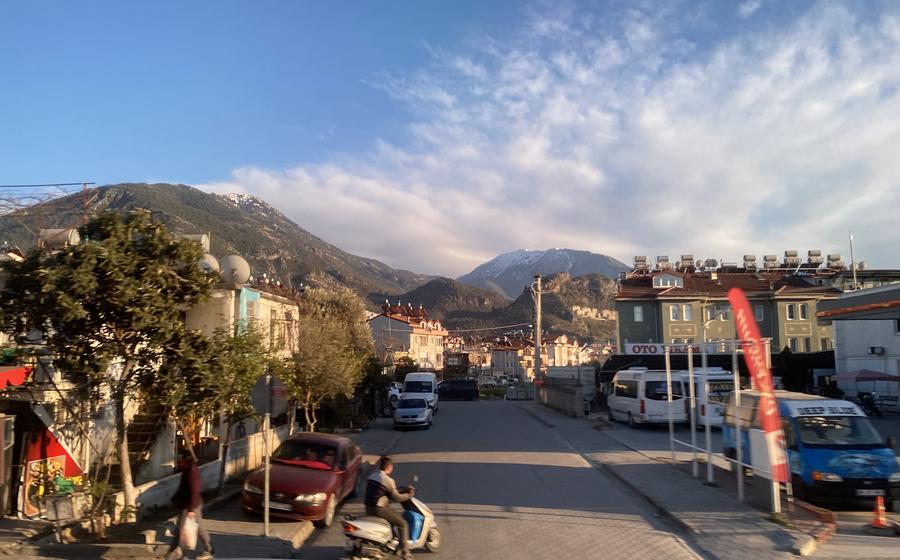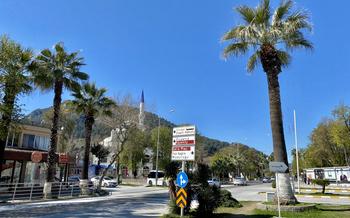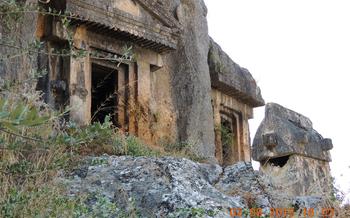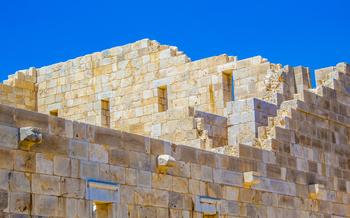
Xanthos Ancient City
- Xanthos Ancient City: A Journey Through History
- The Xanthos Stele: A Bilingual Masterpiece
- The Xanthos Theatre: A Stage for Ancient Performances
- The Xanthos Acropolis: A Citadel of Power
- The Xanthos Agora: A Marketplace and Civic Center
- The Xanthos Museum: A Treasure Trove of Artifacts
- The Xanthos Obelisk: A Symbol of Victory
- The Xanthos Aqueduct: An Engineering Marvel
- The Xanthos City Walls: A Defensive Barrier
- The Xanthos Necropolis: A City of the Dead
- The Xanthos Byzantine Church: A Legacy of Christianity
- The Xanthos Olive Groves: A Culinary Delight
- The Xanthos Festivals and Events: A Celebration of Culture
- Insider Tip: Unveiling the Secrets of Xanthos
Xanthos Ancient City: A Journey Through History
Xanthos, an ancient city nestled in the picturesque region of Muğla, Turkey, invites you on a captivating journey through time. Steeped in historical significance, Xanthos served as the capital of the Lycian League, a powerful confederation of cities that flourished in ancient Anatolia. Its strategic location at the crossroads of trade routes and its proximity to the Mediterranean Sea propelled Xanthos to prominence as a thriving commercial and cultural hub.
As you step into this archaeological wonderland, prepare to be mesmerized by the architectural wonders that have stood the test of time. Xanthos boasts an impressive collection of well-preserved ruins, including the Xanthos Theatre, the Xanthos Acropolis, and the Xanthos Agora. These architectural masterpieces showcase the city's advanced engineering skills and artistic prowess, offering a glimpse into the lives and achievements of its ancient inhabitants.
Enrich your understanding of Xanthos's rich history through the archaeological excavations that continue to unearth valuable artifacts and shed light on the city's past. Discover the secrets of ancient civilizations as you explore the remains of temples, tombs, and public buildings, each narrating tales of Xanthos's glorious past.
The Xanthos Stele: A Bilingual Masterpiece
In 1838, a remarkable discovery was made amidst the ruins of Xanthos: a large stone stele, or inscribed pillar, bearing inscriptions in three distinct languages – Lycian, Greek, and Aramaic. This extraordinary artifact, known as the Xanthos Stele, has since become a centerpiece of the British Museum's collection and a significant source of historical knowledge about the ancient Lycian civilization.
The stele's trilingual inscriptions provide a unique glimpse into the political and cultural dynamics of the region during the 4th century BC. The Lycian text, the most extensive of the three, records a decree issued by the Lycian League, a confederation of Lycian cities. The Greek text, a summary of the Lycian decree, offers insights into the relationship between the Lycians and the neighboring Greek city-states. The Aramaic text, the shortest of the three, serves as a translation of the Lycian decree for the benefit of the Persian authorities, who ruled over the region at the time.
The Xanthos Stele stands as a testament to the cultural diversity and multilingualism that characterized the ancient world. It highlights the importance of communication and diplomacy in facilitating interactions between different linguistic and cultural groups. This remarkable artifact provides a valuable window into the rich history and cultural heritage of the Lycian civilization, offering insights into their political, social, and linguistic practices.
The Xanthos Theatre: A Stage for Ancient Performances
Nestled amidst the ancient ruins of Xanthos, the Xanthos Theatre stands as a testament to the city's vibrant cultural life. Built in the 4th century BC, this impressive structure served as a venue for theatrical performances, musical concerts, and religious ceremonies that played a crucial role in the social and cultural fabric of Xanthos.
The theatre's strategic location, nestled within the natural contours of a hillside, provided excellent acoustics, ensuring that the voices of actors and musicians could be heard clearly throughout the auditorium. The seating arrangement, comprising concentric rows of stone benches, accommodated a substantial audience, allowing the entire community to gather for these cultural events.
Beyond its practical function, the Xanthos Theatre also showcased remarkable architectural features. The stage, adorned with intricate carvings and sculptures, provided a grand backdrop for performances, while the surrounding walls featured decorative niches and columns that added to the theatre's aesthetic appeal.
The theatre's acoustics were carefully engineered to enhance the audience's experience. The design of the seating rows, the shape of the stage, and the positioning of the backdrop all contributed to the exceptional sound quality, ensuring that every word and note could be heard with clarity and resonance.
The Xanthos Theatre was not merely a venue for entertainment but also a significant site for religious rituals and ceremonies. Plays and performances often incorporated religious themes, honoring the gods and goddesses of the Lycian pantheon. These performances served as a means of expressing devotion, seeking divine favor, and strengthening the community's spiritual bonds.
The Xanthos Acropolis: A Citadel of Power
The Xanthos Acropolis, perched atop a hill overlooking the ancient city, served as the fortified citadel and administrative center of Xanthos. Its strategic location provided a commanding view of the surrounding landscape, making it an ideal defensive position. The acropolis was enclosed by massive walls, punctuated by imposing gateways that controlled access to the city.
Within the acropolis, a complex of buildings served various functions. Administrative offices, where officials conducted the city's affairs, lined the streets. Temples and religious sanctuaries, dedicated to the gods and goddesses of the Lycian pantheon, provided a sacred space for worship and rituals. The acropolis also housed the residences of the city's elite, who enjoyed the prestige and security of living within the citadel.
The most striking feature of the acropolis is its panoramic views. From the ramparts and towers, visitors can gaze out over the sprawling ruins of Xanthos, the fertile Xanthos Valley, and the distant peaks of the Taurus Mountains. This breathtaking vista offers a glimpse into the grandeur and power of the ancient city that once stood here.
The Xanthos Agora: A Marketplace and Civic Center
The Xanthos Agora, or marketplace, was the bustling heart of the ancient city. Located at the city's center, it was a vibrant hub of commercial activity, civic gatherings, and social interactions. The agora was a large, open square surrounded by shops, stalls, and public buildings.
Merchants from across the region gathered here to trade their wares, from local agricultural products to imported goods. The agora was also a place for artisans to showcase their skills, selling handmade crafts, jewelry, and pottery. The air was filled with the sounds of haggling, laughter, and the clinking of coins.
Beyond its commercial significance, the agora served as a civic center. Public buildings, such as the council chamber and the law courts, were located here, where citizens could participate in the decision-making processes of the city. Statues of prominent citizens and deities adorned the agora, adding to its grandeur and civic pride.
The agora was not just a place of business and politics but also a social gathering place. People from all walks of life came here to socialize, exchange news, and catch up on the latest gossip. It was a place to meet friends, make new connections, and celebrate special occasions.
The Xanthos Agora was a testament to the city's prosperity and its vibrant civic life. It was a place where commerce, politics, and social interactions intersected, creating a dynamic and diverse urban environment.
The Xanthos Museum: A Treasure Trove of Artifacts
Nestled in the heart of modern-day Xanthos, the Xanthos Museum stands as a repository of the city's rich past. This treasure trove of artifacts offers visitors a glimpse into the remarkable history and culture of ancient Xanthos.
The museum's collection is a diverse array of sculptures, inscriptions, and pottery, each piece carefully preserved and displayed to showcase the artistic prowess and craftsmanship of the Lycians. Among the most notable exhibits are the intricate friezes depicting scenes from Lycian mythology and daily life, as well as the impressive collection of funerary stelae, which provide valuable insights into Lycian funerary practices and beliefs.
Beyond its archaeological significance, the Xanthos Museum also serves as an educational center, offering visitors the opportunity to learn more about the Lycian civilization through interactive exhibits and informative displays. Guided tours are available for those seeking a deeper understanding of the museum's collection and the history of Xanthos.
Whether you are a history buff, an art enthusiast, or simply curious about the ancient world, a visit to the Xanthos Museum is an enriching experience that should not be missed. Immerse yourself in the captivating stories of Xanthos, as revealed through its precious artifacts, and gain a profound appreciation for the legacy of this remarkable city.
The Xanthos Obelisk: A Symbol of Victory
Standing proudly in the heart of the Xanthos Ancient City, the Xanthos Obelisk is a monolithic monument that has captivated visitors for centuries. This impressive structure, crafted from a single block of white marble, serves as a testament to the Lycian civilization's military prowess and rich cultural heritage.
The obelisk's significance lies in its commemoration of a significant military victory achieved by the Lycians. Adorned with intricate carvings and inscriptions, the monument narrates the tale of a triumphant battle, paying homage to the bravery and resilience of the Lycian warriors. The obelisk's inscriptions provide valuable insights into Lycian history, shedding light on their military campaigns, political alliances, and cultural traditions.
Beyond its historical significance, the Xanthos Obelisk is an artistic masterpiece, showcasing the Lycians' exceptional craftsmanship and attention to detail. The intricate carvings that adorn the obelisk depict scenes of battle, victory celebrations, and religious rituals, offering a glimpse into the vibrant and multifaceted Lycian society.
As visitors marvel at the obelisk's grandeur, they can't help but feel a sense of awe and admiration for the Lycian civilization. This remarkable monument stands as a symbol of their military achievements, cultural identity, and enduring legacy, reminding us of the rich history that permeates every corner of the Xanthos Ancient City.
The Xanthos Aqueduct: An Engineering Marvel
The Xanthos Aqueduct stands as a testament to the engineering prowess of the ancient Lycians. Constructed in the 2nd century AD, this impressive structure brought water from a distant spring to the city of Xanthos, ensuring a reliable water supply for its inhabitants.
Built using local limestone, the aqueduct stretched for over 25 kilometers, traversing rugged terrain and crossing valleys and ravines. Its carefully engineered design incorporated arches, tunnels, and channels, demonstrating the Lycians' mastery of hydraulics and construction techniques.
The aqueduct supplied water to the city's fountains, baths, and homes, significantly improving the quality of life for Xanthos's residents. It also played a vital role in irrigation, supporting agricultural activities in the surrounding countryside.
Today, the remains of the Xanthos Aqueduct offer a glimpse into the ingenuity and resourcefulness of the ancient Lycians. Visitors can explore the ruins of the aqueduct's arches and channels, marveling at the engineering feats of a civilization that thrived centuries ago.
The Xanthos City Walls: A Defensive Barrier
The fortifications surrounding Xanthos were a testament to its strategic importance and the resilience of its people. Constructed from sturdy stone blocks, the walls stood tall and imposing, providing a formidable defense against potential invaders. Gates, strategically positioned at intervals, allowed for controlled access to the city, while watchtowers offered a panoramic view of the surrounding landscape, enabling the inhabitants to spot approaching threats.
The construction of the city walls was a testament to the engineering prowess of the Xanthians. Using advanced techniques and local materials, they created a defensive system that was both strong and durable. The walls' thickness and height provided a formidable barrier, while the sloping design helped to deflect projectiles.
Throughout its history, Xanthos withstood numerous sieges and battles, its fortifications playing a crucial role in protecting its citizens. The strength and resilience of the city walls were a symbol of the determination and defiance of the Xanthians, who refused to bow to their enemies.
The Xanthos Necropolis: A City of the Dead
Lying to the east of the ancient city, the Xanthos Necropolis is an extensive expanse of burial grounds that offers a glimpse into the funerary practices of the Lycians. With its array of tombs and burial chambers, each bearing unique architectural features and inscriptions, the necropolis serves as a silent testament to the rich cultural heritage of Xanthos.
The Lycians believed in the afterlife, and their burial practices reflected this belief. Tombs were often elaborate, with intricate carvings and inscriptions that recounted the lives of the deceased. Some tombs were adorned with sculptures and friezes depicting scenes from mythology or daily life. The variety of tombs in the necropolis reflects the social hierarchy of Xanthos, with grander tombs reserved for individuals of higher status.
Beyond the physical remains, the Xanthos Necropolis is also a place of great archaeological significance. Excavations have uncovered a wealth of artifacts, including jewelry, pottery, and coins, providing valuable insights into the daily lives and customs of the Lycians. The necropolis also sheds light on the religious beliefs and rituals associated with death, offering a glimpse into the spiritual world of this ancient civilization.
The Xanthos Byzantine Church: A Legacy of Christianity
Nestled amidst the ancient ruins of Xanthos, the Byzantine Church stands as a testament to the city's rich religious history. Built during the Byzantine era, which spanned from the 4th to the 15th century AD, the church represents the Christianization of the region and the shift from pagan beliefs.
Featuring a traditional basilica design, the church showcases a rectangular layout with a central nave flanked by side aisles. Its walls, though weathered by time, still bear remnants of intricate frescoes and mosaics that depict biblical scenes and figures. These artworks offer a glimpse into the religious iconography and artistic expressions of the Byzantine period.
The church's location within the ancient city emphasizes the significance of Christianity in Xanthos during that era. It served as a place of worship, community gatherings, and religious ceremonies, reflecting the deep-rooted Christian faith that permeated Byzantine society.
Today, the Xanthos Byzantine Church stands as a reminder of the city's diverse religious heritage and its role as a crossroads of cultures and beliefs. Visitors can explore the church's ruins, admire its architectural features, and delve into the history of Christianity in this ancient land.
The Xanthos Olive Groves: A Culinary Delight
In the fertile valleys surrounding the ancient city of Xanthos, olive groves thrive, their silvery-green leaves rustling in the Mediterranean breeze. These groves hold a special place in the region's culinary heritage, producing olives renowned for their rich flavor and exceptional quality.
Olive cultivation has deep roots in Xanthos, dating back to ancient times. The Lycians, who once inhabited this region, held the olive tree in high regard, considering it a symbol of abundance and prosperity. They carefully tended their olive groves, cultivating varieties that flourished in the region's unique climate and soil conditions.
Today, the tradition of olive cultivation continues in Xanthos, with local farmers nurturing their groves with the same care and dedication as their ancestors. The olives are harvested by hand, a time-honored practice that ensures the utmost quality.
Once harvested, the olives are processed using traditional methods to produce extra virgin olive oil. This liquid gold, with its distinctive aroma and taste, is a staple of the local cuisine, adding a rich depth of flavor to dishes ranging from simple salads to elaborate stews.
Visitors to Xanthos have the opportunity to immerse themselves in the region's olive culture by visiting the groves, learning about the cultivation process, and sampling the freshly pressed olive oil. Local farmers are often happy to share their knowledge and passion for their craft, providing visitors with a truly authentic experience.
Whether you're a foodie, a history buff, or simply someone who appreciates the beauty of nature, Xanthos's olive groves are a must-visit destination. Immerse yourself in the region's culinary traditions, savor the flavors of freshly harvested olives, and discover the secrets behind this ancient city's enduring love affair with the olive tree.
The Xanthos Festivals and Events: A Celebration of Culture
Xanthos comes alive during its annual festivals and events, offering visitors a chance to immerse themselves in the city's rich culture and heritage. The Xanthos Festival of Ancient Civilizations takes place in August, featuring music, dance, and theater performances that bring the ancient world to life. The Xanthos Olive Festival, held in October, celebrates the city's renowned olive groves with tastings, demonstrations, and traditional olive oil competitions.
The Xanthos International Sculpture Symposium attracts renowned artists from around the world to create sculptures inspired by the city's history and environment. These sculptures are then exhibited throughout the city, providing a unique outdoor art gallery. For those interested in local crafts, the Xanthos Handicrafts Fair showcases the work of local artisans, including pottery, weaving, and jewelry making.
During these festivals, the streets of Xanthos are filled with music, laughter, and the aromas of delicious local cuisine. Visitors can enjoy traditional Turkish dishes, sample regional wines, and experience the warmth and hospitality of the local people. Xanthos's festivals and events are a wonderful way to learn about the city's past, celebrate its present, and connect with its vibrant community.
Insider Tip: Unveiling the Secrets of Xanthos
To fully immerse yourself in the wonders of Xanthos, consider hiring a knowledgeable guide who can share captivating stories and provide insights into the ancient city's history and significance. These guides often lead small groups through the ruins, ensuring a personalized and enriching experience.
Don't forget to capture the beauty of Xanthos through your lens. The ancient ruins, stunning landscapes, and vibrant culture provide ample opportunities for photography enthusiasts. Remember to be respectful when taking pictures of people, especially during religious ceremonies or private events.
For the best experience, plan your visit to Xanthos during the shoulder seasons (April-May and September-October) when the weather is pleasant and the crowds are smaller. This will allow you to explore the site at a leisurely pace and avoid the summer heat.
As a responsible traveler, embrace sustainable tourism practices by minimizing your environmental impact. Respect the local culture and customs, and support local businesses by purchasing souvenirs and dining at traditional restaurants. Together, we can preserve and protect the unique heritage of Xanthos for generations to come.









